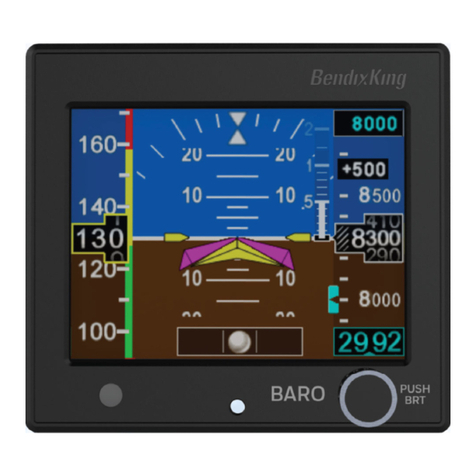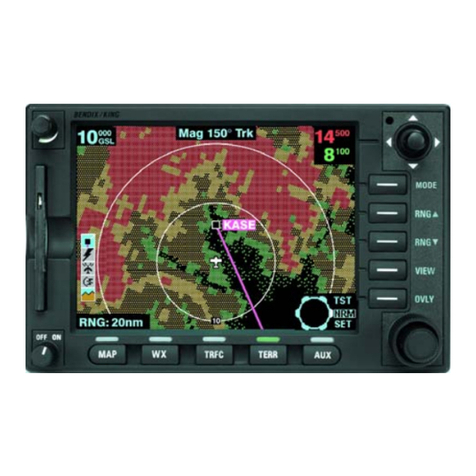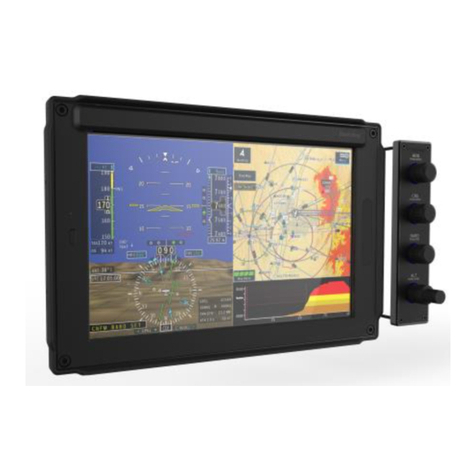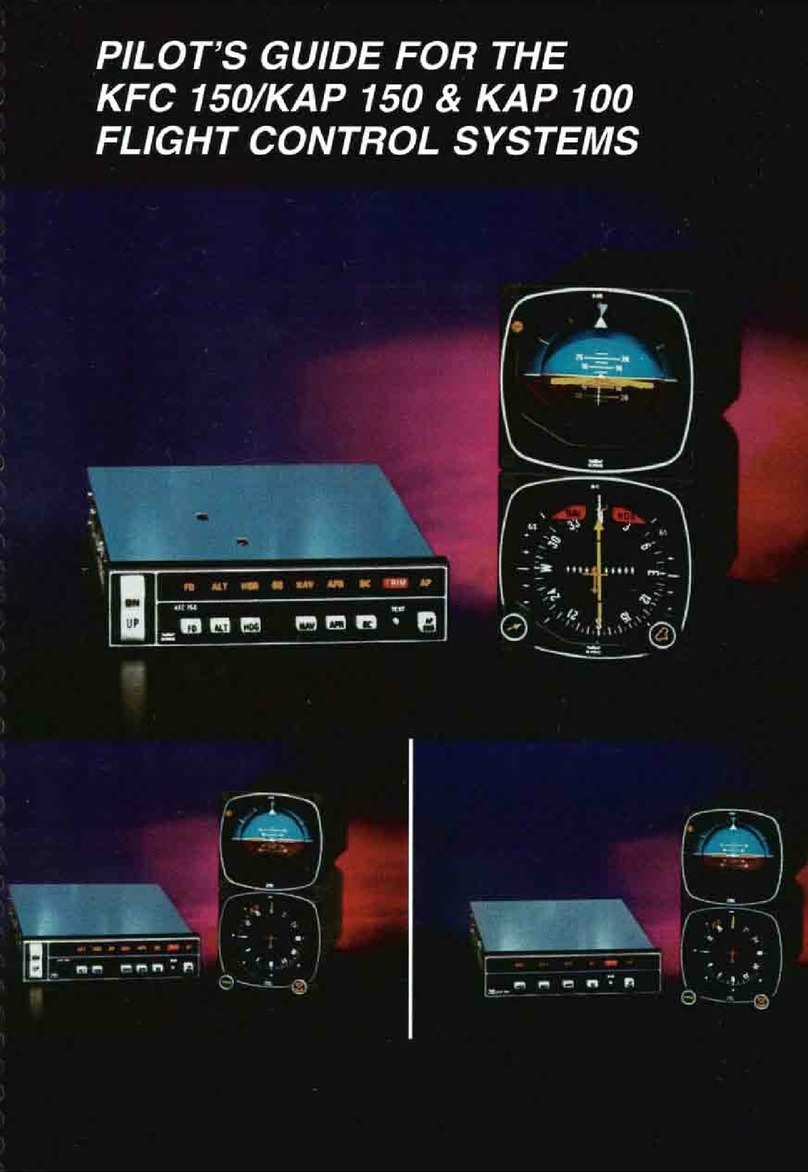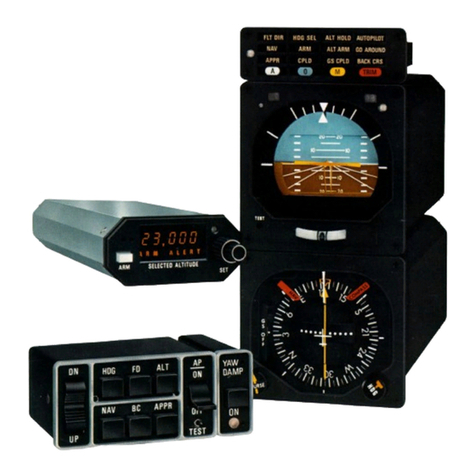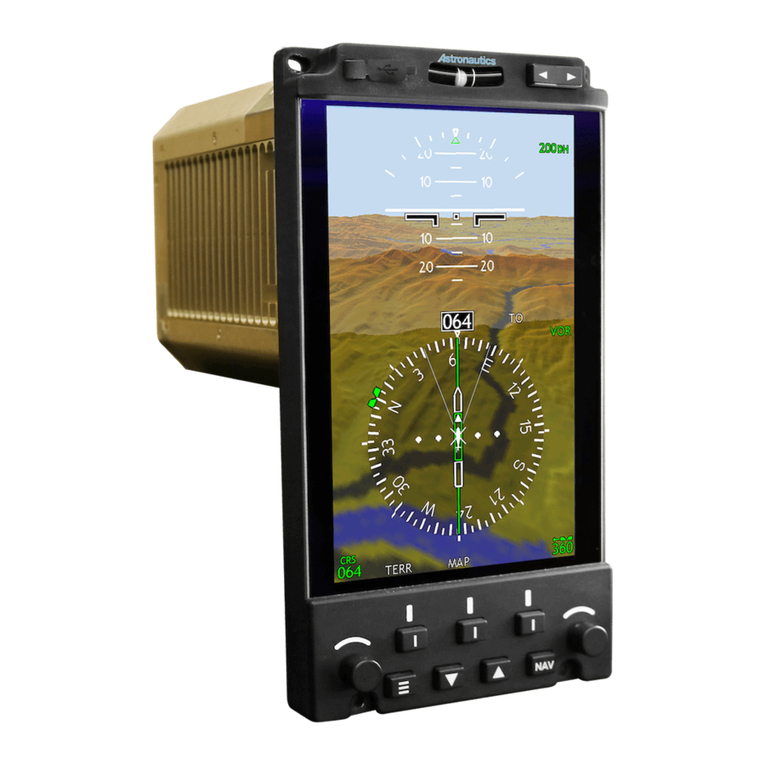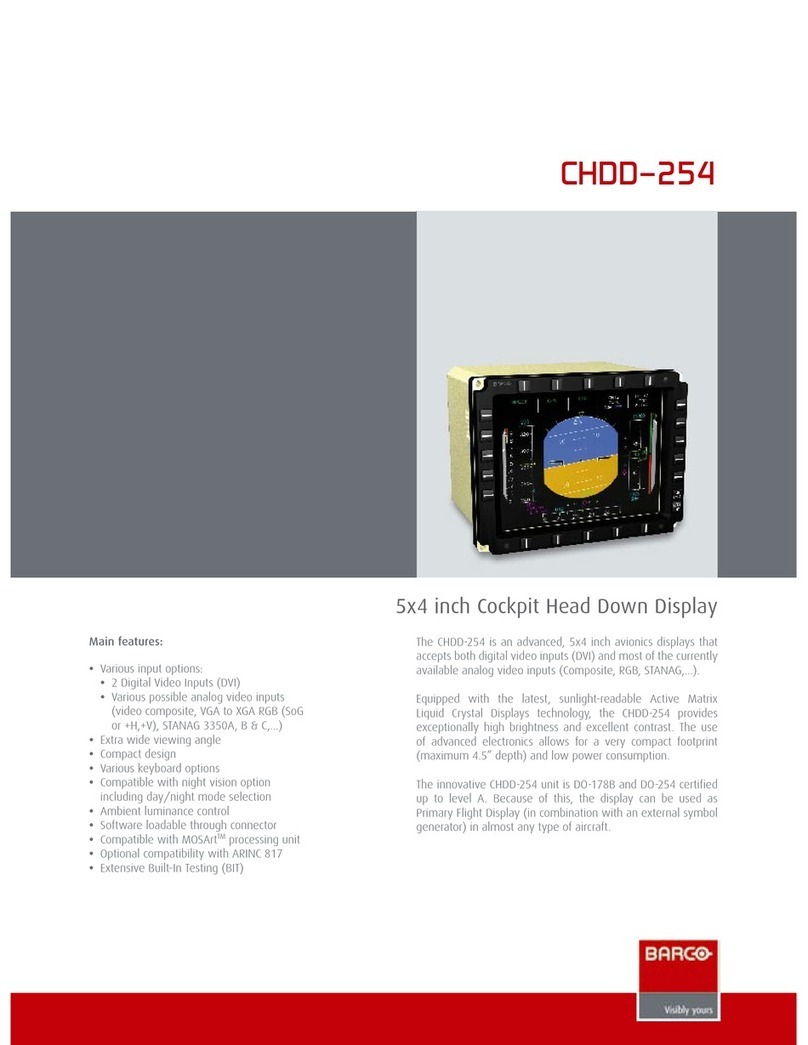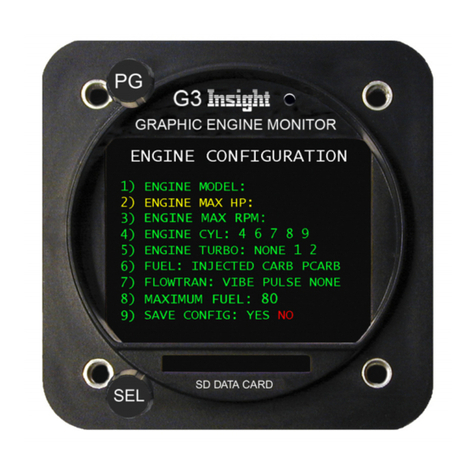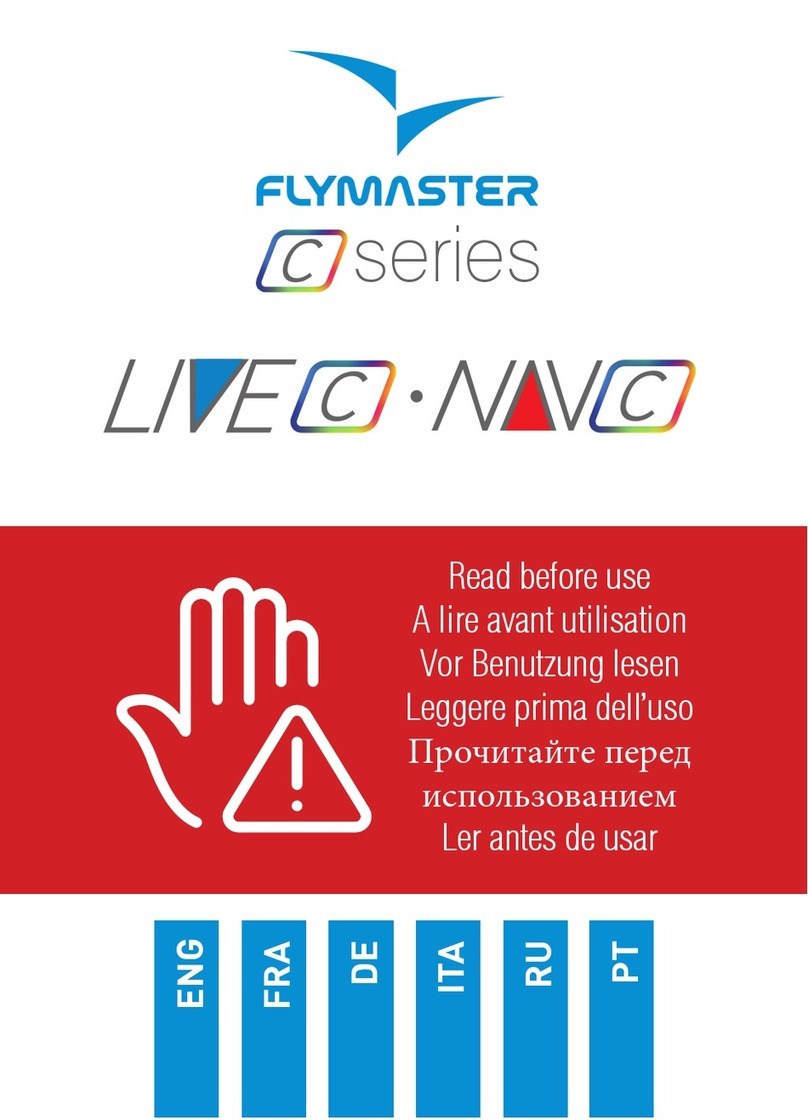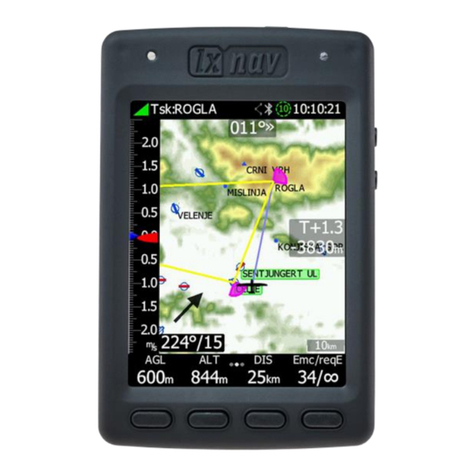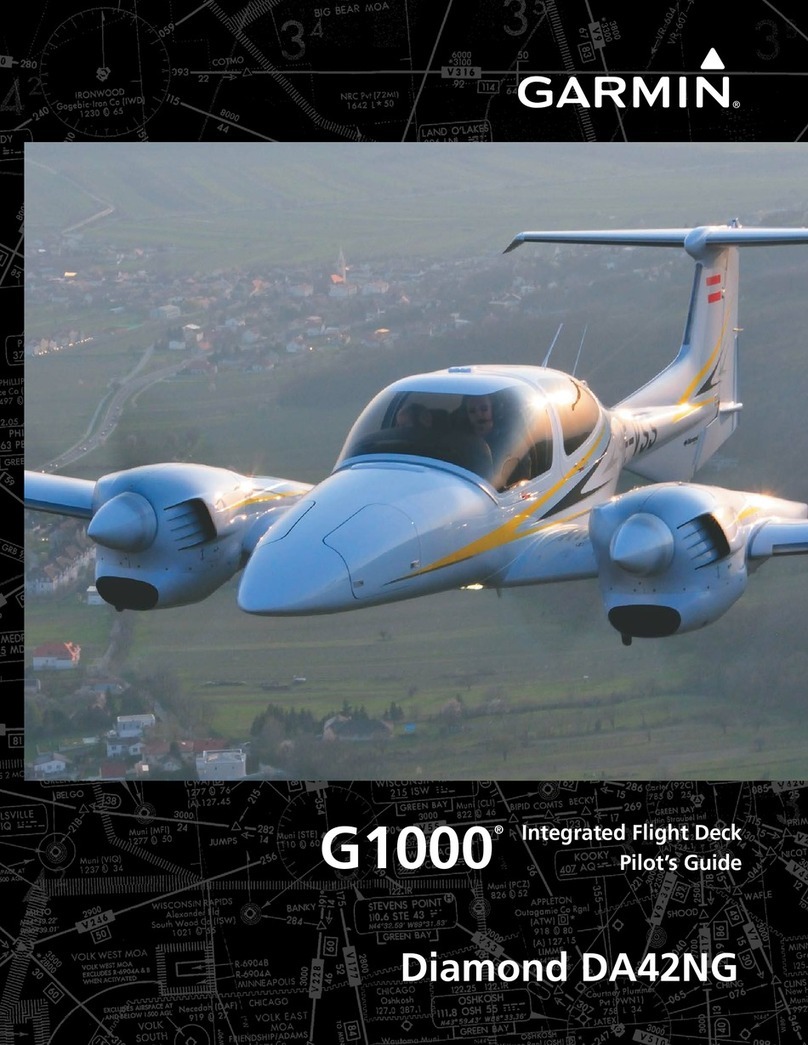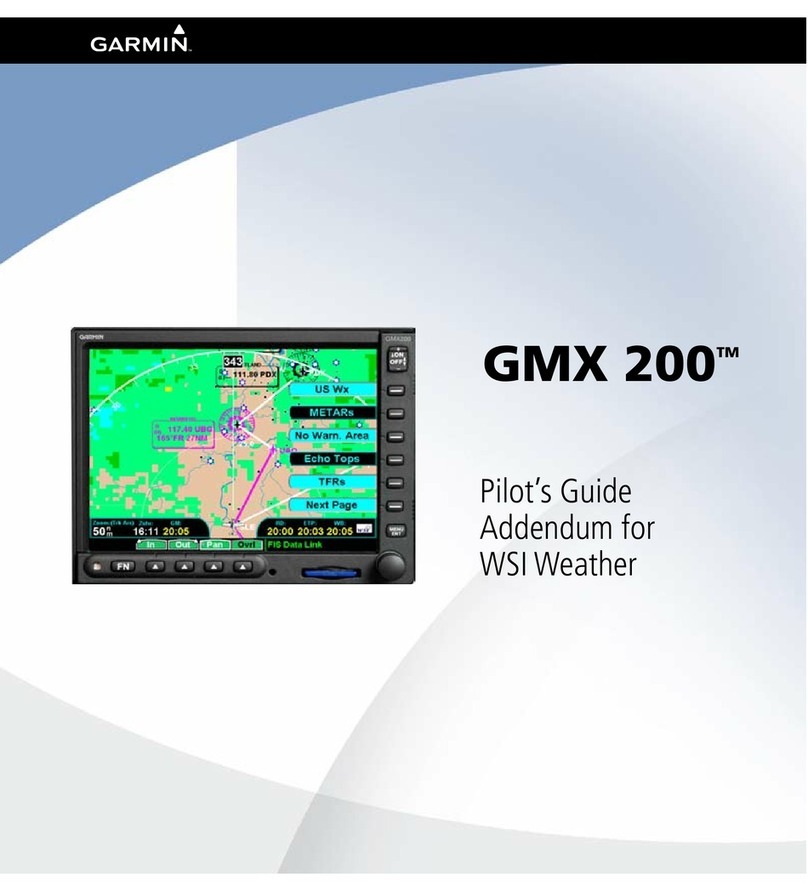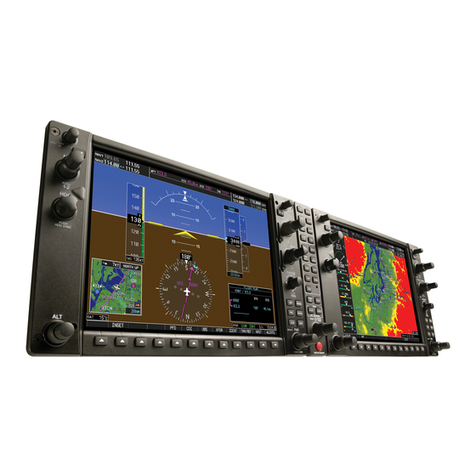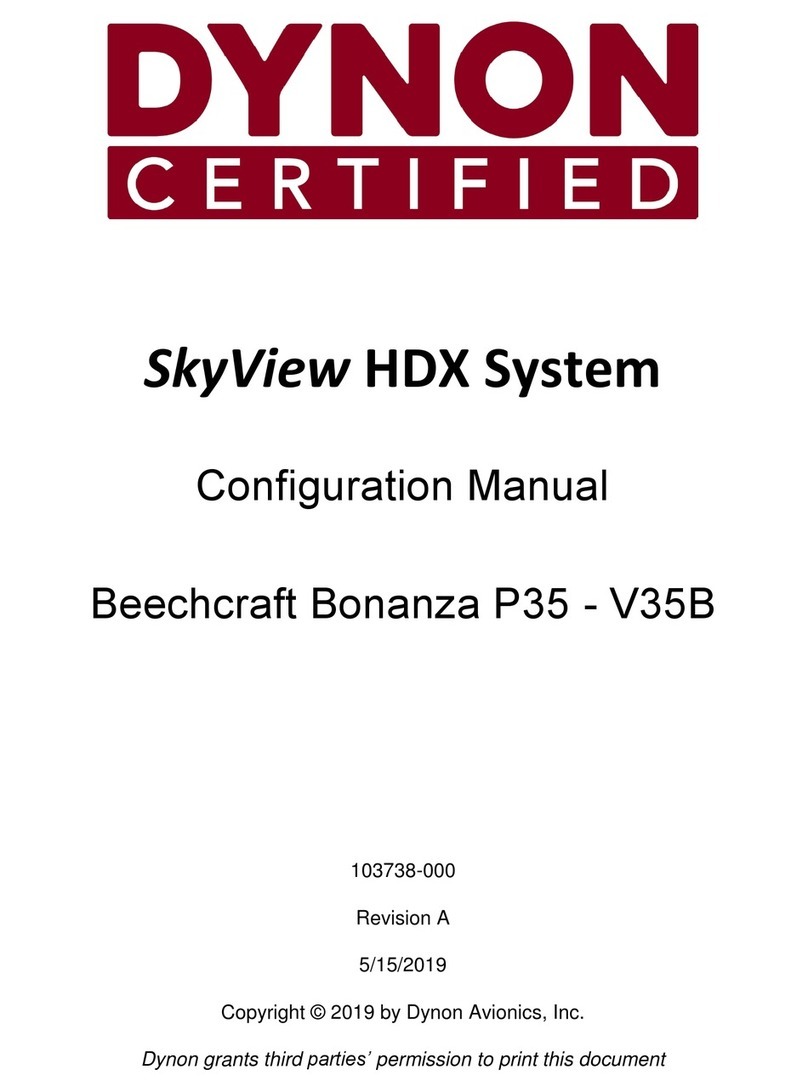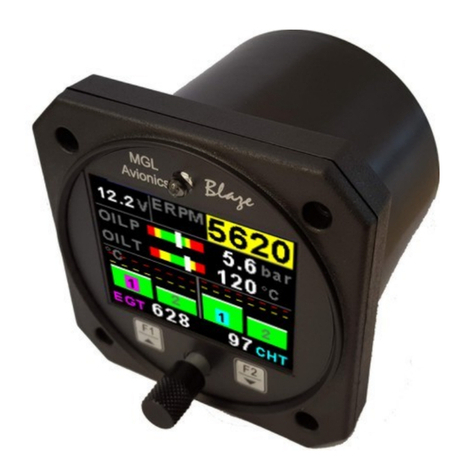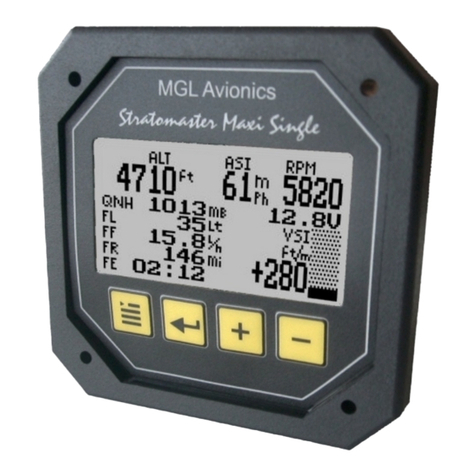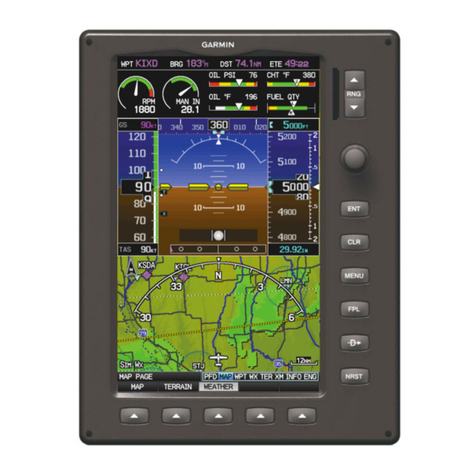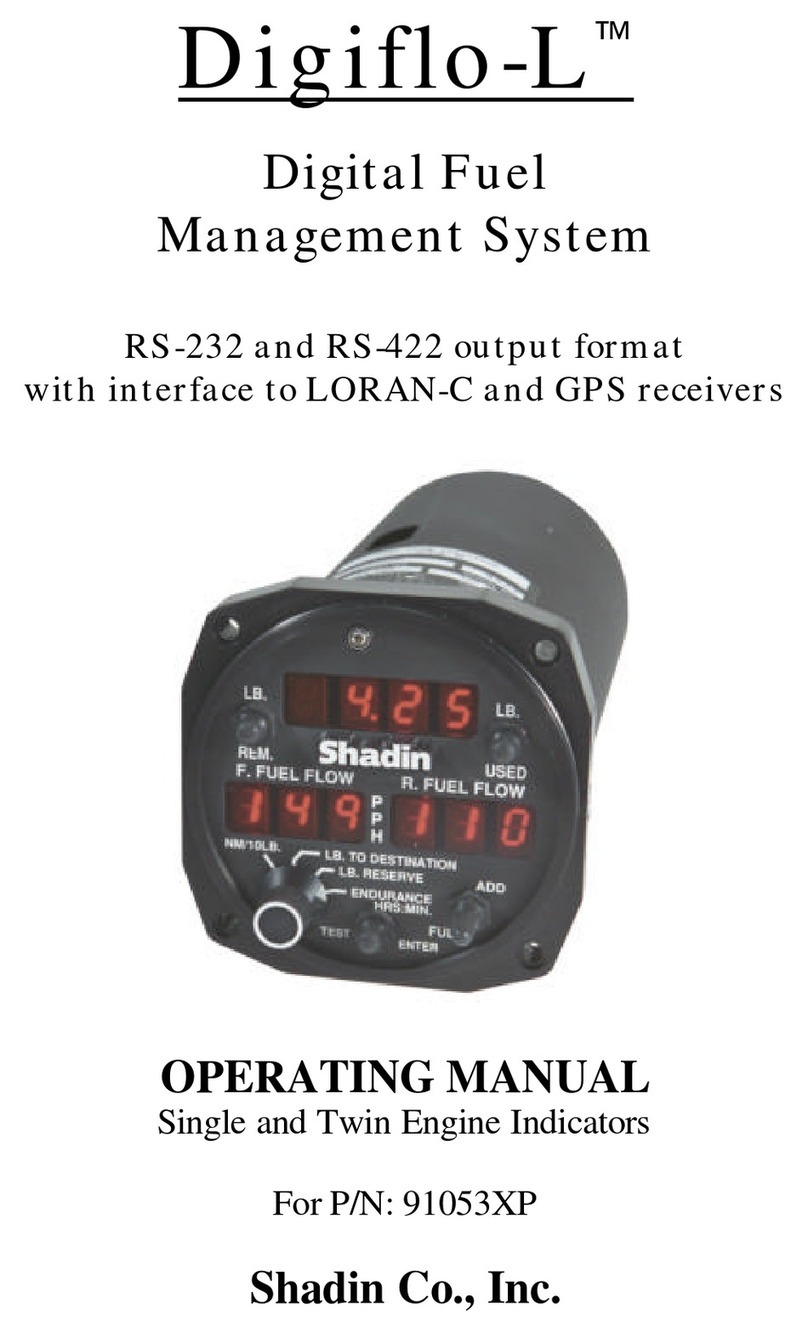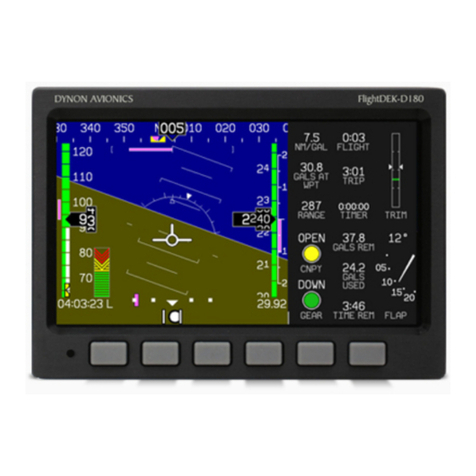BENDIXKing Skymap IIIC Manual

Pilot’s Guide
CAS 66A
BTCAS I
Collision Avoidance System
Effective Date: 2/06 006-08746-0000 REV. 7
Cover & such 2/8/06 3:55 PM Page 1

The information contained in this manual is for reference use only. If
any information contained herein conflicts with similar information
contained in the Airplane Flight Manual Supplement, the information in
the Airplane Flight Manual Supplement shall take precedence.
WARNING
The enclosed technical data is eligible for export under Licanse Designation NLR
and is to be used solely by the individual/organization to whom it is addressed.
Diversion contrary to U.S. law is prohibited.
COPYRIGHT NOTICE
Copyright ©1994-1999, 2004, 2006 Honeywell International Inc.
All rights reserved.
Reproduction of this publication or any portion thereof by any means without the
express written permission of Honeywell International Inc. is prohibited. For further
information contact Technical Publications; Honeywell; One Technology Center;
23500 West 105th Street; Olathe, Kansas 66061. Telephone: (913) 712-0400.
Cover & such 2/8/06 3:55 PM Page 2

SYSTEM COMPONENTS ................................................................1
Traffic Displays: ...........................................................................1
TCAS Controls .............................................................................1
INTRODUCTION ..............................................................................2
TCAS: ..........................................................................................3
SECTION I : THEORY OF OPERATION AND SYMBOLOGY .....5
TCAS OPERATION .....................................................................6
TCAS I Sensitivity Level .........................................................6
TCAS I Surveillance Volumes ................................................8
Range Tracking Volumes ..................................................8
Altitude Tracking Volumes .................................................8
TCAS I Aural Inhibits ..............................................................8
TCAS TRAFFIC DISPLAY SYMBOLS ........................................9
Non-Threat Traffic ...................................................................9
Proximity Intruder Traffic .......................................................10
Traffic Advisory (TA) .............................................................10
Off Scale Traffic ....................................................................11
INDICATIONS AND VOICE ANNOUNCEMENTS .....................12
TCAS Traffic Advisory Annunciation .....................................12
SECTION I I: CONTROLS AND DISPLAYS .................................13
TCAS CONTROLS ....................................................................14
TCAS I Control Panel; CP 66A .............................................14
TCAS I Control Panel; CP 66B .............................................16
TRANSPONDER/TCAS CONTROLS ........................................18
KFS 578A Transponder/TCAS Control Unit .........................18
PS 578A Transponder/TCAS Control Unit ............................21
CD 671C Transponder/TCAS Control Unit ...........................24
PS 550 Transponder/TCAS Control Unit ..............................28
TRAFFIC DISPLAYS .................................................................32
TA/VSI & TID CONTROLS ........................................................33
Range Select ........................................................................33
BRT Control ..........................................................................33
TA SEL Mode .......................................................................33
Light Sensor ..........................................................................33
MODE & FAILURE ANNUNCIATIONS .....................................34
WEATHER RADAR INDICATORS ...........................................34
RDS 81, 82, 84 & 86, RDR 2000, RDR 2100
and Primus /Collins Color Indicators ...............................34
Weather Only Mode ..............................................................35
Weather with TCAS Traffic Mode .........................................35
TCAS Only Mode ..................................................................36
WX & TCAS MESSAGE FORMATS ..........................................36
TCAS Mode Annunciations ...................................................36
TCAS Fault Annunciations ....................................................37
TCAS ONLY mode ...............................................................37
Table of ContentsCAS 66A Pilot's Guide
Effective Date 6/04006-08746-0000 Rev 6 i
TOC 2/8/06 3:55 PM Page 1

SECTION III: OPERATIONAL PROCEDURES ............................39
TCAS OPERATING PROCEDURES ........................................40
Before Takeoff .....................................................................40
Flight Procedures .................................................................40
After Landing ........................................................................41
Post Flight .......................................................................41
SECTION IV: SYSTEM CONSIDERATIONS ................................43
LIMITATIONS AND NOTES ......................................................44
Limitations .............................................................................44
Notes .....................................................................................44
APPENDIX: TCAS I SELF TEST ..................................................47
TCAS SELF TEST .....................................................................48
FAILURE CONDITIONS ............................................................49
CP 66A/B Control Panel Test ...............................................49
IVA 81A/C/D & TID 66A/D Optional Lamp Test ....................50
Radio Altimeter .....................................................................50
GLOSSARY OF TCAS TERMS .................................................50
Abbreviations and Definitions ...............................................50
Table of Contents
Effective Date 2/06 ii 006-08746-0000 Rev 7
TOC 2/8/06 3:55 PM Page 2

SYSTEM COMPONENTS
TRAFFIC DISPLAYS:
IVA 81A/C/D & TID 66A/D,
Compatible Radar Indicators via GC 362A,
Compatible EFIS.
TCAS CONTROLS
CP 66A/B TCAS I Controller
CD 671C, KFS 578A, PS 578A & PS 550 TCAS/Transponder
Controllers
Discretes
TPU 66A & ANT 67A W/ OPTIONAL OMNI.
System ComponentsCAS 66A Pilot's Guide
Effective Date 2/06006-08746-0000 Rev 7 1
Control Options
PWR FL
SBY
TCAS Discretes
TST A/B
OR
OR
OR
Use only one option
Traffic Displays Options
OR
TA
SEL
BRT
RNG 5
.5
2
1
0
.5
12
4
6
4
+12
-12
+08
+03
UP
RNG 5
+03
BENDIX
TST
SBY
ON
GAIN
UP
0
DN
BRT
Wx
WxA RNG
RNG
LOG
TRK
TRK
NAV
MAP
GND
MAP
OFF
U 2.0
80
60
40
20
WXA
GC 362A
TCAS
GRAPHIC
UNIT
EFS
SG
Audio to Speaker
or Audio Panel
3 ATI TA/VSI 3 ATI Dedicated
Traffic Display
Radar Display
EFIS MFD Display
AIRCRAFT SYSTEMS
• Radio Altimeter
• Pitch, Roll & Heading
• Barometric Altitude
• Suppression
• Discretes
SBY
FL T/Wx
RNG
RNG
TST
PWR
ABOVE
NORM
BELOW
SBY
ON
Wx
T/Wx
TCAS
TPU 66A
ı
TPU 66A
TCAS I
PROCESSOR
FWD
FWD
Top Directional
ANT 67A
Bottom Directional
ANT 67A
Bottom Omni-Directional
L-Band AntennaAURAL SYSTEM
• Cockpit Speaker
• Headphones
PUSH
TST
SBY
ON
ALT VFR
TA
XPDR/TCAS
^
^
1/2
I
D
T
ı
2200
2
R
TA/ R A 5
< >
IDT
FL
RANGE
DN
ı
6
3
E
12
5
ABOVE
NM
03
09
09
13
ON
TST
40
20
15
10
53
PUSH TO TST
TCAS
WX
T/WX
TCAS
PUSH FOR FL
BELOW
NORM
ABOVE
SBY
OFF
B
FL
FAIL
TST
SBY
ON
R 1
IDT
ALT
OFF
VFR
1 2 IDT
RANGE TA
TPR/
TCAS
PUSH
FL
<>
T/Wx
CAS 66A TCAS I Block Diagram
TCAS I Pilots Guide 2/8/06 3:52 PM Page 1

INTRODUCTION
TCAS (an acronym formed from the phrase Traffic Alert and Collision
Avoidance System) is an airborne system used for detecting and
tracking aircraft near your own aircraft. TCAS I includes a TCAS
processor, antennas, a traffic display and a means to control the sys-
tem. The TCAS processor and antennas detect and track other air-
craft by interrogating their transponders. Aircraft detected, tracked,
and displayed by TCAS are referred to as Intruders. TCAS analyzes
the transponder replies to determine range, bearing and relative alti-
tude, if the Intruder is reporting altitude. Should the TCAS processor
determine that a possible collision hazard exists, it issues visual and
aural advisories to the crew. The visual advisory is shown by symbols
on the traffic display. Complementing the traffic display, TCAS pro-
vides appropriate synthesized voice announcements in the cockpit. A
complete list of traffic symbols and announcements is given in the
Theory of Operation and Symbology section of this Pilot’s Guide.
TCAS is unable to detect any Intruding aircraft without an oper-
ating transponder. TCAS can detect and track aircraft with
either an ATCRBS (operating in Mode A or C) or Mode S
transponders.
The traffic display shows the Intruding aircraft’s position. TCAS identi-
fies the relative threat of each Intruder by using various symbols and
colors. The Intruder’s altitude, relative to your own aircraft’s altitude, is
annunciated if the Intruder is reporting altitude. A trend arrow is used
to indicate if the Intruder is climbing or descending more than 500 feet
per minute. TCAS traffic may be displayed on a weather radar indica-
tor, on a dedicated TCAS display, on a TCAS compatible EFIS
Display Unit or a TA/VSI (combination traffic display and vertical
speed instrument).
TCAS modes and functions are controlled by switches located on a
TCAS control panel or in combination with various other controls. A
description of controls is given in the Controls and Displays section of
this Pilot’s Guide.
ATC procedures and the “see and avoid concept” will continue to be
the primary means of ensuring aircraft separation. However, if com-
munication is lost with ATC, TCAS adds a significant backup for colli-
sion avoidance.
Introduction
2
Effective Date 6/94 006-08746-0000 Rev 2
TCAS I Pilots Guide 2/8/06 3:52 PM Page 2

TCAS:
• Is compatible with the ATC System
• Determines if a threat exists from ATCRBS or Mode S Transponder
equipped aircraft
• Provides display and audio announcement to the crew
- Position information displayed on a traffic display
- Synthesized voice
• Incorporates sensor inputs and sophisticated algorithms to minimize
nuisance visual and aural annunciations.
IntroductionCAS 66A Pilot's Guide
Effective Date 5/99006-08746-0000 Rev 5 3
TCAS I Pilots Guide 2/8/06 3:52 PM Page 3

006-08746-0000 Rev 0
Theory of Operation and Symbology
4
Effective Date 5/93
TTHHIISSPPAAGGEEIINNTTEENNTTIIOONNAALLLLYYLLEEFFTTBBLLAANNKK
TCAS I Pilots Guide 2/8/06 3:52 PM Page 4

SECTION I : THEORY OF OPERATION AND
SYMBOLOGY
SECTION I DESCRIBES TCAS I THEORY OF OPERATION AND
SYMBOLOGY.
Theory of Operation and SymbologyCAS 66A Pilot's Guide
Effective Date 5/93006-08746-0000 Rev 0 5
+05
TA ONLY
RNG 10
TCAS I Pilots Guide 2/8/06 3:52 PM Page 5

TCAS OPERATION
TCAS monitors the airspace surrounding your aircraft by interrogating
the transponder of the Intruding aircraft. The interrogation reply
enables TCAS to compute the following information about the
Intruder:
1. Range between your aircraft and the Intruder.
2. Relative bearing to the Intruder.
3. Altitude and vertical speed of the Intruder, if the Intruder is
reporting altitude.
4. Closing rate between the Intruder and your aircraft.
Using this data TCAS predicts the time to, and the separation at, the
Intruder’s Closest Point of Approach (CPA). Should TCAS predict that
certain safe boundaries may be violated, it will issue a Traffic Advisory
(TA) to alert the crew that closing traffic is nearby.
TCAS I SENSITIVITY LEVEL
TCAS I separates the surrounding airspace into two altitude layers. A
different sensitivity threshold level for issuing TAs (traffic advisories) is
applied to each altitude layer. Lower altitudes have less sensitive TA
threshold levels to prevent unnecessary advisories in the higher traffic
densities anticipated at lower flight levels, i.e., terminal areas.
TCAS I has two sensitivity levels (SL) which are described in Table 1,
TCAS Sensitivity Levels. SL A is invoked using the following order of
precedence: (1) when the TCAS aircraft is below 2,000 feet AGL (if
equipped with radio altimeter) OR (2) when the landing gear is
Extended (no radio altimeter installed). SL B occurs under all other
flight conditions. Table 2, Typical Traffic Advisory Conditions for
Sensitivity Levels describes what conditions will cause a TA to be
issued. If aircraft is not equipped with either a radio altimeter or
retractable landing gear, TCAS I will stay in SL B at all times.
Sensitivity
Level DESCRIPTION
SL A In sensitivity level A, TCAS I performs surveillance and tracking
functions and provides traffic advisories. The conditions for sensi-
tivity level A are any one of the following:
(1) Own aircraft is in-flight and is below 2,000 feet AGL, if a
radio altimeter is installed.
(2) Own aircraft is in-flight and the Landing Gear is extended, if a
radio altimeter is NOT installed.
Theory of Operation and Symbology
6
Effective Date 6/94 006-08746-0000 Rev 2
TCAS I Pilots Guide 2/8/06 3:52 PM Page 6

SL B In sensitivity level B, TCAS I performs surveillance and tracking
functions and provides traffic advisories. The conditions for sen-
sitivity level B are based on own aircraft in-flight and:
(1) If radio altitude source is installed and own aircraft altitude is
above 2,000 feet AGL (radio altitude).
(2) If radio altitude source is NOT installed and own aircraft has
Landing Gear Retracted.
(3) If the aircraft has a fixed landing gear and no radio altimeter is
installed.
Table 1: TCAS Sensitivity Levels
Sensitivity
Level CONDITIONS FOR TRAFFIC ADVISORIES (TAs)
SL A The following conditions cause TCAS I to generate a TA in sensi-
tivity level A:
• TCAS calculates that if current closing rate is maintained, sep-
aration of less than 600 feet in altitude between own and
Intruder will occur in 20 seconds.
• Separation between own and Intruder is less than 1200 feet in
altitude and less than 0.20 nautical mile range.
• NAR (Non-Altitude Reporting) Intruder is within 15 seconds or
0.20 nautical mile range.
SL B The following conditions cause TCAS I to generate a TA in sensi-
tivity level B:
• TCAS I calculates that if current closing rate is maintained, sep-
aration of less than 800 feet in altitude between own and
Intruder will occur in 30 seconds.
• Separation between own and Intruder is less than 800 feet in
altitude and less than 0.55 nautical miles in range.
• NAR (Non-Altitude Reporting) Intruder is within 20 seconds or
0.55 nautical mile range.
Standby
or Fail • TAs are not generated.
Mode
Table 2: Typical Traffic Advisory Conditions for Sensitivity Levels
Theory of Operation and SymbologyCAS 66A Pilot's Guide
Effective Date 6/94006-08746-0000 Rev 2 7
TCAS I Pilots Guide 2/8/06 3:52 PM Page 7

TCAS I SURVEILLANCE VOLUMES
Surveillance volume is that volume of airspace within which other air-
craft with Mode S or ATCRBS transponders are tracked by own air-
craft’s TCAS.
(1) Range Tracking Volumes
The shape and size of the range tracking volume is dependent on
whether Mode S or ATCRBS transponders are being interrogated,
whether tracking is occurring on a directional or OMNI antenna, and
attenuation levels applied to the transmitted pulses from the TCAS
processor’s transmitter. The typical range tracking volume is pictured
as an ellipse. The distance behind own-aircraft is about one half of
the forward distance. The tracking range to either side of own-aircraft
is about two thirds of the maximum forward distance.
The maximum forward range for TCAS is 40 nm. TCAS reduces
range tracking volumes in high density areas to reduce the number of
receptions to be processed by TCAS and for interference limiting.
TCAS can track as many as 45 aircraft and displays up to 30 of them.
(2) Altitude Tracking Volumes
TCAS I tracks other transponder equipped aircraft that are within a rel-
ative altitude of +/-9,000 feet.
TCAS I AURAL INHIBITS
TCAS I will inhibit the aural annunciation using the following order of
precedence: (1) below 400 feet AGL (if equipped with radio altimeter)
OR (2) when the landing gear is Extended (no radio altimeter
installed). For installations aboard aircraft with fixed landing gear, the
aural annunciation is never inhibited by the TCAS I processor. The
aural annunciation is enabled above 600 feet AGL in aircraft equipped
with a radio altimeter.
Theory of Operation and Symbology
8
Effective Date 5/93 006-08746-0000 Rev 0
TCAS I Pilots Guide 2/8/06 3:52 PM Page 8

TCAS TRAFFIC DISPLAY SYMBOLS
TCAS I will display three different traffic symbols on the traffic display.
The type of symbol selected by TCAS is based on the Intruder’s loca-
tion and closing rate. Relative bearing and distance to the Intruder are
shown by the position of the Intruder symbol in relation to the own-air-
craft symbol.
The symbols change shape and color as separation decreases
between your aircraft and Intruders to represent increasing levels of
urgency.
The traffic symbols may also have an associated altitude tag that
shows relative altitude in hundreds of feet, indicating whether the
Intruder is climbing, flying level or descending. A + sign and number
above the symbol means the Intruder is above your altitude. A - sign
and number beneath indicates the Intruder is below your altitude. A
trend arrow appears when the Intruder’s vertical rate is 500 feet per
minute or greater.
No altitude number or trend arrow will appear beside any Intruder that
is Non-Altitude Reporting (NAR).
If TCAS direction finding techniques fail to locate the azimuth of anoth-
er aircraft, a NO BEARING message appears on the screen when the
Intruder becomes a threat.
NON-THREAT TRAFFIC
An open white diamond indicates that an Intruder’s
relative altitude is greater than ±1200 feet, or its dis-
tance is beyond 5 nm range. It is not yet considered
a threat.
This traffic is 1700 feet above your own altitude,
descending at 500 feet per minute or greater.
Theory of Operation and SymbologyCAS 66A Pilot's Guide
Effective Date 5/93006-08746-0000 Rev 0 9
+17
RNG 5
+17
+1700 Ft. and
Descending
TCAS I Pilots Guide 2/8/06 3:52 PM Page 9

PROXIMITY INTRUDER TRAFFIC
A filled white diamond indicates that the Intruding air-
craft is within ±1200 feet and within 5 nm range, but
is still not considered a threat.
This Intruder is now 1000 feet above your aircraft and
descending.
TRAFFIC ADVISORY (TA)
A symbol change to a filled yellow circle indicates that the Intruding
aircraft is considered to be potentially hazardous. Depending upon
TCAS sensitivity level, TCAS I will display a TA when time to CPA
(Closest Point of Approach) is 15 to 30 seconds.
Here the Intruder is 500 feet above your aircraft. A
voice is heard in the cockpit, advising:
“Traffic, Traffic”
The crew should attempt to gain visual contact with
the Intruder and be prepared to maneuver upon visu-
al acquisition.
The crew should take
no evasive action
based solely on the
TCAS display.
Theory of Operation and Symbology
10
Effective Date 6/94 006-08746-0000 Rev 2
+10
RNG 3
+10
+1000 Ft. and
Descending
+05
RNG 3
+05
+500 Ft.
TCAS I Pilots Guide 2/8/06 3:52 PM Page 10

OFF SCALE TRAFFIC
Threat aircraft (TA’s) that are beyond the selected display range are
indicated by one half of the traffic symbol at the edge of the screen.
The position of the half-symbol represents the bearing of the Intruder.
TA traffic on 5 mile range.
Same TA traffic; beyond selected range.
Theory of Operation and SymbologyCAS 66A Pilot's Guide
Effective Date 6/94006-08746-0000 Rev 2 11
-05
TA ONLY
RNG 5
RNG 3
-05
TA ONLY
TCAS I Pilots Guide 2/8/06 3:52 PM Page 11

INDICATIONS AND VOICE ANNOUNCEMENTS
“Traffic, Traffic”
Situation:
One Intruder is ahead near the 2:00 o’clock position, between 2 and 3
miles, 400 feet below your altitude and closing. TCAS recognizes the
threat and issues a TA.
TCAS TRAFFIC ADVISORY ANNUNCIATION (TA):
IMPORTANT:
The pilot should NOT initiate evasive maneuvers using information
on the Traffic Display only. Use the TA (Traffic Advisory) symbol to
visually acquire the Intruder and be prepared to maneuver upon
visual acquisition.
Audio Announcements:
Synthesized voice announcements are issued by TCAS over the air-
craft audio system. The following table lists all the audio messages,
and advisories, in the TCAS I vocabulary.
Audio Messages
006-08746-0000 Rev 4
12
Effective Date 8/98
Theory of Operation and Symbology
RNG 5
-04
TA ONLY
“TRAFFIC, TRAFFIC”
Aural Visual Crew Response
Conduct visual search for the
Intruder. If successful, maintain
visual acquisition to ensure
safe operation.
A filled yellow circle on the
Traffic Display
Traffic Advisory “TRAFFIC, TRAFFIC”
If Previous TA is Active “TRAFFIC”
Self Test Passed “TCAS SYSTEM TEST OK”
Self Test Failed “TCAS SYSTEM TEST FAIL”
CONDITION ADVISORY MESSAGE
TCAS I Pilots Guide 2/8/06 3:52 PM Page 12

SECTION II: CONTROLS AND DISPLAYS
SECTION II DESCRIBES CONTROLS AND
DISPLAYS OF THE TCAS I EQUIPMENT.
Controls and DisplaysCAS 66A Pilot's Guide
Effective Date 6/94006-08746-0000 Rev 2 13
ON
TST
40
20
15
10
53
PUSH TO TST
TCAS
WX
T/WX
TCAS
PUSH FOR FL
BELOW
NORM
ABOVE
SBY
OFF
B
FL
FAIL
TCAS I Pilots Guide 2/8/06 3:52 PM Page 13

TCAS CONTROLS
This section describes the control units for the TCAS equipment.
Several types of control units are described. The TCAS functions can
be controlled by various control panels or discrete switches. Not all
the functions described are required in every installation.
TCAS I CONTROL PANEL; CP 66A
CP 66A
TCAS I Control Panel
Note: The controls vary depending on CP 66A/CP 66B configuration
installed. All functions are the same as typical of units shown.
Pushing the PWR push button cycles the TCAS ON or
OFF. At power down, the control panel senses
whether the TCAS is in SBY or On mode. Upon power-
up, the control returns the TCAS to the same condition.
Whenever TCAS is On, pressing SBY places the TCAS
in SBY (Standby) mode. In Standby mode, all TCAS
broadcast, surveillance, and tracking operations are
disabled and the traffic display is blanked except for a
“TCAS STBY” mode annunciation. If TCAS is in
Standby, pressing the SBY button places TCAS I in the
ON mode.
Pushing the TEST button initiates a comprehensive self
test lasting approximately eight seconds. Refer to the
Appendix for a description of the self test function.
Controls and Displays
14
Effective Date 6/94 006-08746-0000 Rev 2
ABOVE
NORM
BELOW
SBY
ON
Wx
T/Wx
TCAS
SBY
FL T/Wx
RNG
RNG
TST
PWR
PWR
SBY
TST
TCAS I Pilots Guide 2/8/06 3:52 PM Page 14

The T/Wx (TCAS/Weather) mode but-
ton is necessary in installations using
the weather radar indicator as the
traffic display. In these installations,
the T/Wx switch is used to select
between Weather Only, Weather with
TCAS Traffic and Traffic Only modes.
Details of the various modes are described later in this section under
Weather Radar Indicators.
TCAS RNG (Range) buttons are used to select the
range on the traffic display. The range selections are
3, 5, 10, 15, 20, and 40. All ranges are in nautical
miles.
Note: This feature may not be available in all installa-
tions or this feature may be superseded by a range
control on the traffic display bezel.
The FL (Flight Level) push button replaces Intruder’s
relative altitude with absolute altitude for 15 seconds.
During this period the altitude is displayed in flight level
format. That is, 19,000 ft. is displayed as 190. After 15
seconds the absolute reading reverts to relative alti-
tude.
The FL function is flagged below 18,000 feet MSL on most traffic dis-
plays unless barometric corrected altitude is available from an air data
source. FL is inhibited on the IVA 81A/C/D and the TID 66A/D units,
but not on the Radar indicator when used with GC 362A.
If FL is selected while inhibited, “FL - - -” will show in place of own
flight level.
The A/B (Above/Below) push button selects altitude display limits.
The Above/Below selection has no effect on the TCAS logic giving
TAs. There are three choices available.
ABOVE Traffic that is between 8700 feet above and 2700 feet below
own aircraft will be displayed.
Typically ABOVE is used during the
climb phase of flight.
NORMAL Traffic that is between
2700 feet above and 2700 feet below
will be displayed. Typically NORMAL
is used during the en route phase of
flight.
Controls and DisplaysCAS 66A Pilot's Guide
Effective Date 2/06006-08746-0000 Rev 7 15
T/Wx
RNG
RNG
FL
ABOVE
NORM
BELOW
SBY
ON
Wx
T/Wx
TCAS
ABOVE
NORM
BELOW
SBY
ON
Wx
T/Wx
TCAS
TCAS I Pilots Guide 2/8/06 3:52 PM Page 15

BELOW Traffic that is between 2700 feet above and 8700 feet below
will be displayed. Typically BELOW is used during the descent phase
of flight.
TCAS I CONTROL PANEL; CP 66B
CP 66B
TCAS I Control Panel
The CP 66B can have up to four separate knobs as shown above.
Depending upon the system interface, the Range Knob and/or Display
Selector may be removed.
The CP 66B amber Fail Annunciator will light during self test and in
normal operation will flash if a system failure has been detected. If a
failure has been detected, turning the Power Switch to OFF will turn
off the flashing annunciator.
Power Switch:
The OFF position deactivates selector switches and
push buttons and extinguishes FAIL annunciation if
on.
The SBY position places the TCAS in Standby mode.
In Standby mode, all TCAS broadcast, surveillance,
and tracking operations are disabled and the traffic display is blanked
except for a “TCAS STBY” mode annunciation.
The ON position enables the TCAS broadcast, tracking and surveil-
lance operations at the selected range, display and altitude limit.
Pressing the TEST button in the center of the knob initiates a compre-
hensive self test lasting approximately eight seconds. Refer to the
Appendix for a description of the self test function.
Controls and Displays
16
Effective Date 8/98 006-08746-0000 Rev 4
ON
TST
40
20
15
10
53
PUSH TO TST
TCAS
WX
T/WX
TCAS
PUSH FOR FL
BELOW
NORM
ABOVE
SBY
OFF
B
FL
FAIL
ON
TST
SBY
OFF
TCAS I Pilots Guide 2/8/06 3:52 PM Page 16
Other manuals for Skymap IIIC
7
Table of contents
Other BENDIXKing Avionic Display manuals
